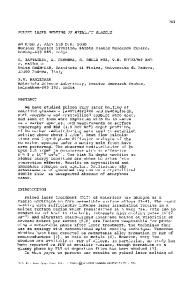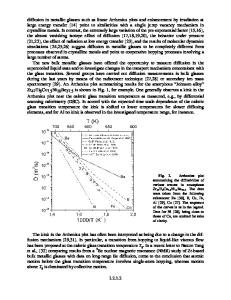Wettability of Electrochemically Nano-textured Metallic Glasses
- PDF / 1,206,095 Bytes
- 8 Pages / 612 x 792 pts (letter) Page_size
- 12 Downloads / 308 Views
Wettability of Electrochemically Nano-textured Metallic Glasses Harpreet Singh Arora1#, Sundeep Mukherjee1 1 Department of Materials Science and Engineering, University of North Texas, Denton, TX 76203, USA #
Email: [email protected], Phone no. +1-940-535-8166
ABSTRACT Different surface patterns with nanometer length-scales were obtained by electrochemical processing of metallic glasses. The wetting behaviour of these surface patterns was studied using sessile drop technique with distilled water droplet. It is demonstrated that the hydrophilichydrophobic nature of the metallic glass surface can be controlled through nano topography. The contact angle was found to increase from 70° for the flat metallic glass surface to 112° for the nano-dendritic structure. Atomic force microscopy was utilized to explain the difference in contact angle in term of the surface roughness for different nano-textures. INTRODUCTION Metallic glasses are complex multi-component metallic alloys with a single phase fully amorphous structure. High mechanical strength and perfectly elastic behaviour make them attractive as structural materials [1-4]. Changing the wetting behaviour of metallic glasses can potentially enhance their range of applications. Wettability is strongly dependent on the chemistry and texture of a material’s surface. Electrochemical processing is a versatile technique for controlling the surface morphology and chemistry. It can be performed at room temperature and used for alloys with a wide range of compositions, The influence of materials’ chemistry, morphology, and processing conditions on the wettability has been widely investigated. Wettability of a surface is known to be significantly affected by surface energy and morphology [5]. The influence of surface topography on wettability of polymeric materials has been widely investigated. For example, water contact angle on polystyrene substrate with different nano-textures, including nano-embossed arrays, nano-posts, and aligned nano-fibers was evaluated [6]. A super-hydrophobic polypropylene surface was fabricated using radio-frequency (RF) plasma [7]. Study on dynamic wettability of different surfaces was done to understand the significance of contact angle hysteresis in achieving super-hydrophobicity [8]. Wettability has also been investigated for lithographically patterned micro-textured surfaces [9]. A study on wettability of silicon surfaces with different size, shape, and spacing of posts fabricated using standard lithography techniques has been reported [10]. In comparison to significant amount of work in the field of polymeric materials, there are only limited reports of wettability studies for metallic alloys [11, 12]. Wettability characteristics of different metals with water have been reported under continuous condensing conditions [13]. Most noble metals (including Au, Pd, and Pt) exhibited high contact angle compared to the less noble metals. Some other studies on wettability behavior of metals [14, 15] demonstrated that metal surfaces free from surfa
Data Loading...











